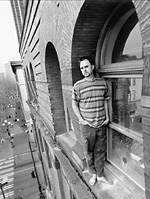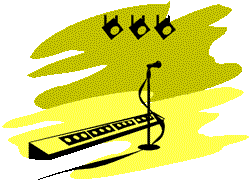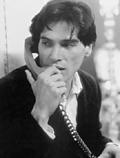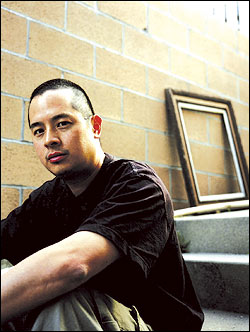IT’S COMING DOWN to money,” says Eddie Maurer, a 56-year-old oil painter and the head of Jem Studios, an artists’ loft and gallery space on the corner of Occidental and Jackson in Pioneer Square. He’s waiting for the start of a tenants’ meeting he helped organize.
“I’ve got the final deal today,” he says, leaning forward in a big easy chair in the corner of longtime resident and stained-glass artist Christine Morgan’s living room. “We’re going to open an escrow account, and anybody who wants to invest in the new building can put money in. . . .” Maurer throws some numbers out for the type of cash that most of these artists do not have at their disposal.
Wayne Walker, a long-haired Jem occupant who looks to be in his 50s, raises an eyebrow. “That’s a daunting task,” he says. Maurer mentions the “Mafia types” he spoke with earlier in the day in hopes of garnering funds. Walker asks if Maurer’s joking. He’s not.
Then Maurer switches gears, mentioning a regular arts patron who might be interested in helping artists who are hoping to get the lease on another cooperative space. Their eyes are on the Griffin Envelope Building, a 54,000-square-foot structure in North Duwamish, which they’d like to purchase outright—eventually. They want something permanent, something that will head off the type of nightmare they’re currently having, where their beloved space—the Washington Shoe Manufacturing Building, which houses Jem Studios—gets pulled out from under them by a landlord who is kicking everybody out and courting the dot-coms.
Last September, the Samis Foundation, the nonprofit corporation that owns the Shoe, announced that Jem’s latest five-year lease, the studio’s fourth, would not be renewed; the building must be vacated by May 1. After that date, work will begin on the Shoe’s conversion. Basement storage space will become 31 parking stalls; the second through fifth floors, currently artist studios or light industrial space, will be turned into offices; the sixth floor will undergo a curious change, as all 12,000 square feet of it will be sculpted into a penthouse suite complete with study, library, landscaped courtyard, and six bedrooms.
It’s a dramatic change from the way the building’s been used since 1980, when Maurer set up shop on the second floor in the abandoned offices of T&M Athletics. Ever since, Maurer has played a kind of spiritual godfather role to the city’s arts community, nurturing new talents by renting them space and showing at the Jackson Street Gallery across the street, where now-accomplished artists like Mike Haskell, Karen Guzak, and Ed Cox debuted their earliest work. Today, Jem is a major attraction of the First Thursday gallery walk, where most of the painters, sculptors, craftmakers, actors, musicians, and photographers who currently occupy the Shoe show—and try to sell—their wares. They won’t be there come the first Thursday in May, however.
This scenario isn’t a total shock: Most of their peers have already been rocked by the effects of downtown Seattle’s seismic real estate shifts. Because of its role as the city’s artistic center, Pioneer Square has evolved from urban ghost town to commercial gold mine, attracting major corporations and well-funded start-up businesses to its brick-lined streets. With this come the usual rent increases and property cost hikes, which in turn have sparked the loss of many of Seattle’s alternative arts spaces. In the last four years, six artists’ buildings with more than 200 studios have closed in Pioneer Square.
THE TENANT’S MEETING gets under way 45 minutes late. Only 11 residents attend. Maurer lays out the proposal he’s given to the owners of the Griffin Envelope Building. The short version: By the end of June, the artists will need to raise $450,000 to have the option of purchasing the Griffin Building. They need $60,000 just to secure its lease. And these proverbial starving artists have six weeks to raise it. A possible investor has offered $20,000, but there’s nothing in the coffers right now. Maurer has considered selling the house in Costa Rica where he’s spent most of the last five years living and painting, but he hopes it doesn’t come to that.
Daniel Fried, a filmmaker and graphic designer, speaks up. He’s eager to get moving. Where Maurer tempers his fervor with an underlying sense of doom, Fried’s enthusiasm remains unchecked. “We need to think about $40,000,” he says. “Does anybody in the room have it? Can anyone raise it?” No hands go up.
Christine Morgan chimes in. “I’ve sent out information to a lot of people who can help,” she says. “We haven’t heard anything yet, but it takes time. . . .” Her voice trails off. Morgan has been working closely with Maurer, driving around looking at spaces, but after close to seven months, the artists have still not found affordable group housing, and what was once a unified front is beginning to come apart. Many of the artists are still unsure where they’ll go come May 1, including Morgan herself.
Still, she attempts to keep everyone’s spirits up. This is no easy task. For one thing, there aren’t as many tenants in the complex as there once were; for a building that regularly counted 70 or 80 residents, there are now only 40, and by the middle of March five of them still haven’t paid their rent for the month, with several more expected to disappear before April. In a building-wide memo, Maurer and Morgan plea: “We still have to keep the lights, water, gas, insurance, and washer/dryers going until the last day. So please get the last of the rents current.”
BY THE TIME Eddie Maurer landed in Seattle, he’d already moved around quite a bit. Born and raised in Detroit, he joined the army when he was 17. Discharged three years later, he armed himself with a sketchbook and typewriter, and spent two years bumming around Europe and Africa. Returning to the US, he enrolled at San Francisco State to study painting and drawing. Four years later, he took his BA and went back to Europe, purchasing a house in Spain, living there and painting midsized oil canvases until 1979.
“By the time I left, Europe was pretty shot,” Maurer says over coffee at Zeitgeist, on the Shoe’s ground floor. “It was getting too expensive. An old Army buddy from Tacoma had offered his cabin in Yelm to paint in. I’d come into Seattle on the weekend to go to bars and clubs, and I grew to like the city. The prices in San Francisco were terrible, so I moved here instead.”
Though the Shoe was decaying when Maurer first discovered it in 1980, the brick office complex was an artist’s dream come true: airy, well-lit, high ceilings, and, most importantly, dirt cheap. “It was exactly what I was looking for,” Maurer says. “I’d always envisioned the building as an artists’ collective.”
Over time, as more space opened up, he was able to implement his vision. By 1990, Maurer was the Shoe’s de facto landlord, renting out all but the ground floor, primarily via word of mouth, to emerging, avant-garde artists. Many moved in after attending Cornish, where Maurer taught for eight years. “I was at the Alaska Building gallery the other day,” he says, “and just about every other piece there was by someone who’d started out here.”
A lot has changed since Maurer signed his first five-year lease. Most importantly, the building’s original owner, Sam Israel, is no longer around. Israel owned 40 Seattle properties—14 in Pioneer Square—and was a notorious, if kindly, slumlord. He maintained slipshod conditions, attending to the rented-out ground floors and roofs but little else. When the 95-year-old Israel died in 1994, his property was ceded to Samis, a charitable organization which mostly funds local education efforts. In the six years since his death, Samis has renovated many of Israel’s properties, including the Corona (at 610 Second Ave) and Terry-Denny (at 113 First Ave S) buildings, under the direction of William Justen, the former director of Seattle’s Department of Construction and Land Use. Justen, who is overseeing the Shoe’s transition into an office building with a vanity penthouse, did not return several calls made by Seattle Weekly for this story.
DESPITE ITS CURRENT incarnation as an artists’ space, the truth is that the Shoe Building is zoned for business, not residential use, and its occupants have long lived there illegally. An office building for most of its existence, Samis’ rehab brings it full circle.
And Samis isn’t a complete villain. Many of the foundation’s developments are considered artist-ready, with a design emphasis on high ceilings, spacious rooms, and natural light. The only hitch is that artists are getting priced out. Many say that housing costs are approaching San Francisco’s—the city whose outlandish rents they sought to escape in coming here.
“You can’t charge a quarter or 50 cents or 75 cents a square foot for space anymore. Samis has a mandate to earn money to distribute,” says David Brunner, a member of the Pioneer Square Community Council. “Some people call it gentrification, but they need to generate some cash flow in order to do this. Sam Israel provided the soil for the artists to grow, and even though it’s really hard to take, you have to till the soil and replant. Maybe in 30 or 50 years it’ll come back around. It’s tough.”
Artists don’t hew to this philosophy, especially when confronted with plans for the penthouse that will loom over their former home. Maurer becomes visibly furious at the thought that there will be one full-time tenant in a building that used to hold 70. A vicious cycle compounds his anger: Artists take over cool old building in neglected area, clean up the building and begin creating there, and revitalize the neighborhood. This paves the way for new businesses and more affluent residents, which in turn push artists off into another uncharted and often unseemly neighborhood to work their magic again.
The cycle used to take “anywhere from a decade to a generation,” says Alex Steffen, president of Allied Arts, an advocacy group. “But now it’s more like two years. Check out Columbia City, and then ask anyone who’s lived there awhile what it was like five years ago, and they’ll tell you it was completely different. The sheer influx of cash has changed the dynamic completely. It’s meant that everything that was marginal is now marketable.”
This has meant a squeezing out of artists who are themselves on the margins. The only full-time artists who can afford most of the spaces currently on the market are commercially oriented. Lofts are now going for $1.60-$1.75 per square foot; the lowest price on one Capitol Hill brochure advertising “artists’ loft spaces” is a whopping $400,000. “Those lofts aren’t for artists,” Maurer says. “They’re for people who want to live the artist lifestyle.”
ACTUAL ARTISTS like the Shoe residents have varying ideas about what this all means and where they’ll go from here.
“Three months from now, there will be more space, and possibly even more artists than there are now,” says Spencer Matthews, a Jem artist who founded the nonprofit coalition SOS (Soul of Seattle) Arts to help preserve affordable live/work spaces. “But it’s getting to the point where you need to make $20,000 a year to afford to live in Seattle. Most full-time artists make between $10,000 and $15,000, if that.”
“There’s nowhere left to go,” argues Leah Mattheis, a copywriter who has lived in the Shoe with her partner, painter Kevin Friberg, for three years. “[Landlords in] Duwamish are holding out until the rents go up so they can sell at a profit. Pioneer Square has been dishing out leases with no intent to sell for a while now.”
“Georgetown is really tight,” says Friberg. “I have a photographer friend who wanted to build a darkroom, which would take a year to do. He was offered a six-month lease.”
“We’re really on the fence,” says Mattheis. “We’re giving all the energy we can to a group movement. If that doesn’t work out, I don’t know what we’ll do. This is an incredible place, there’s so much artistic energy here.”
“We have other friends trying to find a co-op,” says Friberg. “The goal is to have a shared workspace. Part of it is economic, but it’s also about collaborative energy.” This is one reason that the couple is, as Friberg puts it with a smile, “kinda holding out for Eddie’s pipe dream.”
But beyond artists’ personal disadvantage, Seattle’s new financial structure holds other potential hazards. Many say that the disappearance of independent arts studios has a trickle-down effect on the quality of life. “It’s already affected the city,” says City Council member Judy Nicastro. “Artists have historically added a creative dimension to a city, and now they’re being dispersed to outlying areas. And Pioneer Square really was their last spot—there’s really nowhere else for them to go.”
“Places like Pioneer Square—or, five years ago, Belltown—are more than chunks of units,” says Allied Arts’ Steffen. “They’re arts communities, where people go to each other’s shows, network, bounce ideas off one another. To my mind, the Shoe Building is exceptional only in that it is such a clear illustration of a trend. It’s a critical part of First Thursday, so it’s highly visible; it’s work that thousands have seen and enjoyed, so its loss is tangible. It’s like any business: Artists lose customers when they move. And there’s no doubt that artistic and cultural vitality is one of the reasons people like living in Seattle; it’s one of the things that fuels our prosperity. Unfortunately, we have a tendency to think that vitality is a given, that it’ll stay here no matter what, and nothing could be further from the truth.
“Some parts of the arts community are doing OK,” Steffen continues. “But we tend to think that building a new opera hall or having a thriving symphony is the same thing as having a thriving arts community. Look at Pioneer Square, which not that long ago was pretty much abandoned. What made it a vital neighborhood is its arts and nightlife; the kind of vitality you see there is directly related to the artists going in and [creating] a scene. We’re destroying the things that made us a great city, and that will come back to haunt us. If we drive out all our artists, Seattle will be boring and bland.”
BY NOW, YOU MAY be thinking, “Who cares? Why should artists be treated any differently than anybody else? Let them get jobs and work and pay high rents just like the rest of us do.” And it seems logical enough. But consider a couple of things. One, most artists have adapted to holding down day jobs and doing their creating at night. Two, it’s extremely difficult to make art in traditional housing without risking eviction: Few neighbors are willing to tolerate loud music, few landlords will shrug at carpets stained by oil paint.
These problems may be limited to artists, but the economic factors aren’t. As Seattle’s economy continues to expand, so does the gap between the city’s rich and poor. “In terms of economics, artists are the most marginal of the marginal,” says Steffen. “There’s been some sort of tipping point, from everybody knowing one person who’d been evicted to it happening to large numbers at once. The real issue here is not that artists are special or that they deserve more than anybody else, but that they’re an integral part of the community.”
Whether they’re more or less integral than the high-tech companies and dot-com millionaires is hard to say.
“I have no problem with new initiatives coming to Seattle,” says City Council member Nick Licata. “Particularly if they offer middle-class jobs. But the balance is tipped too much in favor of high-tech jobs. It pushes out marginal blue-collar industries as well as artists, and we need to learn how to strike a balance between new industries and old.”
A potentially greater danger is that artists get turned off completely, refusing to strike any balance and giving up their art in order to live a little more comfortably.
For 33-year-old mosaicist and Jem resident Shannon Lindberg, a return to the regular 9-to-5 grind may prove something of a relief. Lindberg graduated from the University of Arizona and ran her own interior design business in Tuscon for two years before returning to Seattle to be near her family when she gave birth to her daughter Skyler, now five. But after the Shoe closes, she won’t be squatting in the new artist enclave, be it in Duwamish or Georgetown or wherever.
“I’m going to move to the Eastside in my single-wide trailer and try to work at a furniture store,” Lindberg says, laughing. “Being a full-time artist is a lot more stressful and a lot more work. When this is all over, I’m getting a job just so I can relax.”








